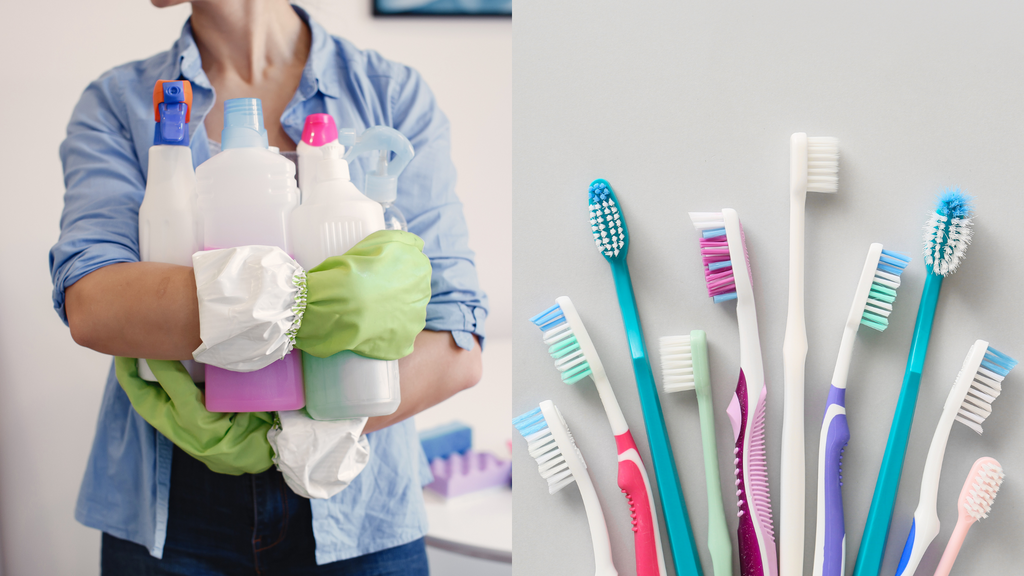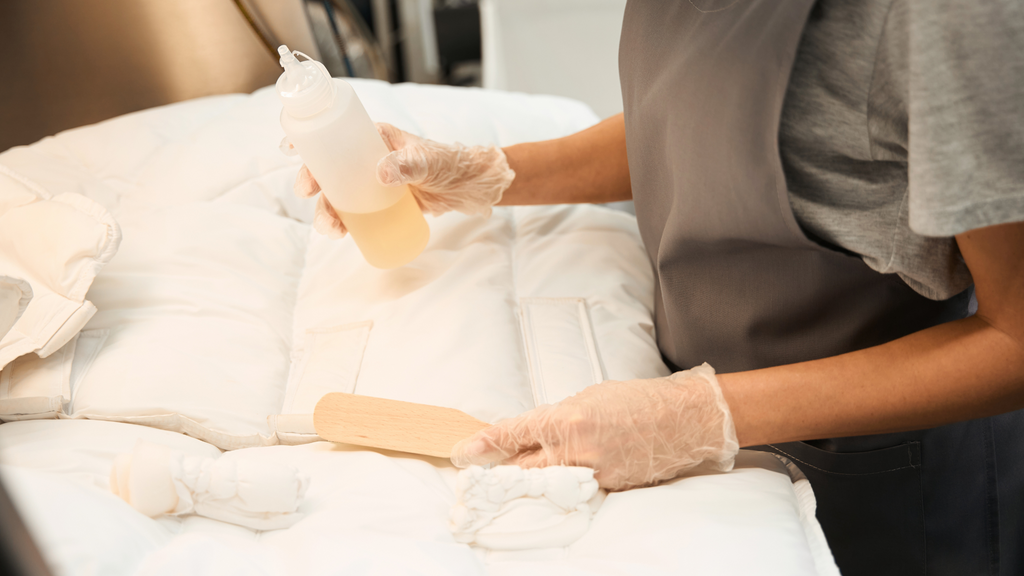A pristine set of bedsheets can become frustrating when confronted with an unexpected and all-too-common challenge: period stains. For many, period stains on bedsheets are a familiar guest during that time of the month. These stains appear out of nowhere, and if not handled promptly, they become stubborn reminders of a monthly inconvenience.
Prepare for the Cleanup by Gathering All Necessary Materials

Before you begin the process of removing period stains from your bedsheets, it's essential to gather all the necessary materials. Having these items on hand will make the cleanup more efficient. Here's a list of the items you'll need:
- Clean Cloth or Paper Towels: You'll need something to blot and absorb the excess menstrual blood, and a clean cloth or disposable paper towels work well for this purpose.
- Cold Water: Cold water is your best friend when treating period stains as it helps prevent the stain from setting in, making it easier to remove later.
- Stain Remover: You can use a commercial stain remover or opt for homemade solutions like hydrogen peroxide, baking soda and water paste. Having a stain remover ready will be crucial for tackling the stain effectively.
- Old Toothbrush or Soft Brush: A soft-bristle brush can help gently agitate the stain remover and loosen the stain from the fabric.
How to Remove the Soiled Bedsheets
Once you've gathered your materials, it's time to remove the soiled bedsheets. Take the following steps:
- Carefully lift the affected bedsheets from your mattress, being cautious not to let the stain spread to other areas.
- If the stain is extensive or has soaked through to the mattress, consider placing a clean, dry towel or cloth underneath the stained area to prevent it from seeping further.
- Remove any additional items from the bed, such as pillows and covers, to prevent them from coming into contact with the stain during the cleanup.
How to Action Immediately
Act Quickly to Prevent the Stain from Setting
When you notice a period stain on your bedsheets, acting promptly is essential. Fresh bloodstains are much easier to remove than dried ones because the longer you wait, the harder it becomes to eradicate the stain. So, as soon as you see the stain, set aside what you're doing and address it immediately.
Blot, Don’t Rub
One of the most common mistakes people make when removing stains is rubbing the affected area vigorously. However, this can make matters worse by pushing the stain deeper into the fabric fibres. Instead, gently blot the stain with a clean cloth or paper towel. Blotting involves pressing down on the stain with an up-and-down motion, which helps to lift the blood out of the fabric and avoid scrubbing or rubbing as it can cause the stain to spread and become more ingrained.
Use Cold Water
Cold water is your best friend when it comes to treating period stains. Avoid hot water at this stage because heat can cause the proteins in the blood to set, making the stain more difficult to remove. Here's how to use cold water effectively:
Soak the Stained Area: After blotting, take a clean cloth or sponge and dampen it with cold water. Dab the stained area with a damp cloth to help dilute and lift the blood.
Repeat as Necessary: If the stain persists, you can soak the affected area in a basin of cold water for 15-30 minutes. Periodically agitate the water to encourage the stain to release.
Avoid Rubbing: While using cold water, avoid rubbing the stain and stick to blotting and dabbing to prevent further spreading.
Avoid Hot Water and Heat Sources
Hot water and heat sources such as hairdryers or radiators can set the stain in the fabric, making it extremely difficult to remove. So, during this initial phase, it's crucial to steer clear of anything that could expose the stain to heat and stick to cold water until you've successfully treated and removed the stain.
Different Stain Removal Techniques

Technique #1: Homemade Stain Remover
Ingredients:
- 1 tablespoon of salt
- 1 tablespoon of baking soda
- 1 tablespoon of cold water
Steps:
- Mix the salt, baking soda, and cold water to paste.
- Apply the paste directly to the stain, covering it completely.
- Allow the paste to sit on the stain for 15-30 minutes to work magic.
- After the paste has had time to penetrate the stain, rinse the area with cold water.
- Check the stain; launder your bedsheets as usual if it's gone or significantly reduced. If not, repeat the process or try another stain removal method.
Note: This homemade stain remover can be particularly effective for fresh period stains.
Technique #2: Commercial Stain Remover
Several commercial stain removers are available on the market, and they can be effective for removing period stains. Here's how to use them:
- Select a Quality Stain Remover: Choose a reputable stain remover product and look for one specifically designed for removing protein-based stains like blood.
- Read and Follow Instructions: Carefully read the instructions on the product label; different stain removers may have slightly different application methods.
- Typically, you'll apply the stain remover directly to the stain and be generous but not excessive with the product.
- Allow Time to Work: Most commercial stain removers require some dwell time to break down the stain and follow the recommended time specified on the product label.
- Launder as Usual: After treating the stain, wash your bedsheets following the care instructions on the label.
Note: Commercial stain removers are convenient and designed to tackle various stains, including period stains.
Technique #3: Hydrogen Peroxide
Hydrogen peroxide can be an effective stain remover for blood stains, but it should be used cautiously, especially on coloured fabrics. Follow these steps for safe use:
- Dilute the Hydrogen Peroxide. Mix one part 3% hydrogen peroxide with two parts cold water to create a diluted solution.
- Spot Test. Before applying the solution to the stain, perform a spot test in an inconspicuous area of the bedsheets to ensure it won't cause colour fading or damage.
- Apply Gently. Dab the diluted hydrogen peroxide onto the stain using a clean cloth or cotton ball, and do not soak the fabric.
- Blot and Rinse. After applying, gently blot the stain and let it sit for a few minutes. Rinse the area with cold water.
- Launder as Usual. Once the stain is treated, launder your bedsheets following the care instructions on the label.
Note: Hydrogen peroxide can be potent, so use it carefully and only on white or colourfast fabrics.
Technique #4: Baking Soda and Water Paste
Baking soda is known for its ability to lift and absorb stains. Here's how to create and use a baking soda and water paste:
- Create the Paste. Mix baking soda with just enough cold water to form a paste with a toothpaste-like consistency.
- Apply the Paste. Spread the baking soda paste evenly over the period stain, covering the affected area.
- Let it Sit. Allow the paste to sit on the stain for 15-30 minutes to give it time to absorb.
- Gently Scrub. Using an old toothbrush or a soft brush, gently scrub the stain in a circular motion and be careful not to damage the fabric.
- Rinse with Cold Water. Rinse the area thoroughly with cold water to remove the paste and any loosened stain particles.
- Launder as Usual. Finally, wash your bedsheets as you normally would, following the care label instructions.
Note: The baking soda and water paste is a mild but effective method for treating period stains and is safe for most fabrics.
Additional Prevention Tips for Period Stains
Use Dark-Coloured or Patterned Bedsheets
Investing in darker or patterned bedsheets for your period can provide peace of mind and make clean-up less stressful because dark colours are less likely to show stains than light-coloured sheets. At the same time, patterns, especially intricate ones, can also help disguise accidental spills.
Consider Using a Mattress Protector
Investing in a high-quality mattress protector is an excellent way to safeguard your mattress against period stains and other accidents. These waterproof or water-resistant covers are designed to shield your mattress from spills and stains, including menstrual accidents. These protectors are typically easy to clean and prevent liquid from seeping through your mattress.
Alternatives to Bedsheets During Your Period
Period-Proof Bedding
Some companies offer period-proof bedding designed to absorb and contain menstrual flow, preventing it from reaching your sheets or mattress, and these products often feature a waterproof layer to protect your mattress further.
Towels or Blankets
Placing an absorbent towel or blanket on your bedsheets can provide an extra layer of protection. While it may not be as comfortable as traditional sheets, it can help catch any unexpected leaks.
Disposable Bed Pads
Disposable bed pads are designed to absorb liquids and are easy to dispose of after use. Often used in healthcare settings can be placed under your sheets to protect your mattress.
Conclusion
Managing period stains on bedsheets can be a breeze with the proper knowledge and preparation. Whether through quick DIY stain removers or investing in period-proof bedding and mattress protectors, these simple steps ensure that your bedsheets remain a sanctuary of comfort and hygiene. Remember, it's not just about maintaining your bed's appearance; it's about reclaiming control over your period and ensuring that it doesn't disrupt your daily life. So, armed with these insights and tips, say goodbye to period stain worries and embrace the freedom to rest easy during your period.








